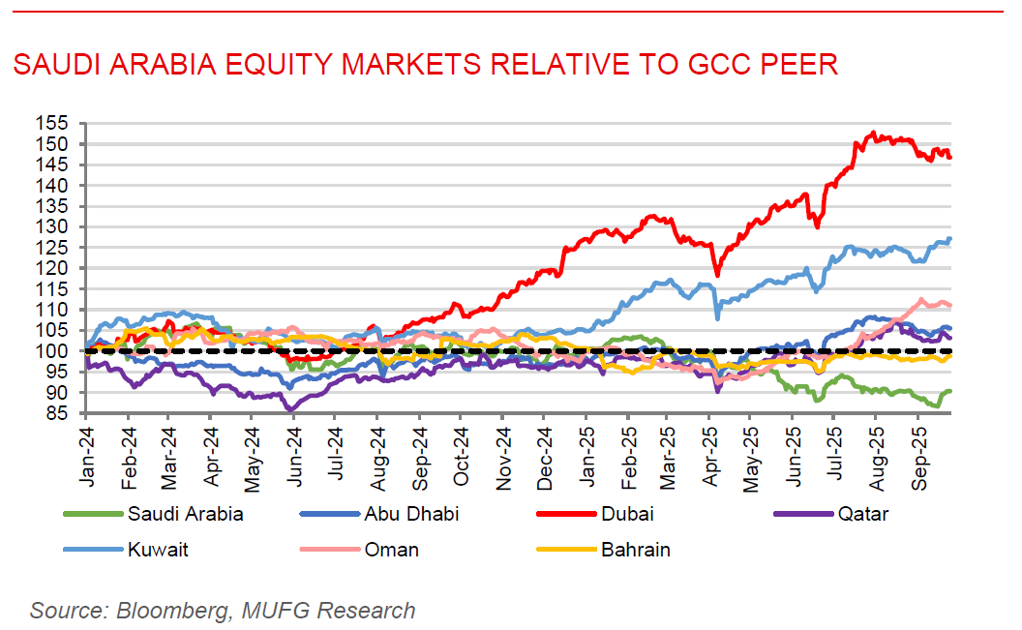To read the full report, please download the PDF above.
Middle East Daily
SOOJIN KIM
Research Analyst
DIFC Branch – Dubai
T: +44(4)387 5031
E: soojin.kim@ae.mufg.jp
MUFG Bank, Ltd. and MUFG Securities plc
A member of MUFG, a global financial group
Middle East Daily
COMMODITIES / ENERGY
Oil gains as Trump escalates pressure on Russia and supply risks mount. Oil prices extended their biggest weekly advance, with Brent nearing USD68/b and WTI around USD64/b, after US president Trump urged NATO nations to shoot down Russian aircraft violating airspace and pressed Europe to curb purchases of Russian energy. He also accused China and India of financing Russia’s war efforts through continued oil imports. At the same time, Russia is considering restricting diesel exports following intensified Ukrainian drone attacks on its energy infrastructure. While bearish fundamentals and the prospect of resumed Kurdish exports from Iraq, potentially adding 230,000b/d, highlight risks of a glut, falling US crude inventories and stronger Brent time spreads suggest tightening near-term market conditions. Traders remain caught between geopolitical tensions and oversupply concerns, leaving oil little changed overall this month.
Gold holds near record as Fed signals mixed and geopolitical risks persist. Gold traded near USD3,761/oz after three straight sessions of setting fresh highs, as investors digested mixed commentary from Fed officials and heightened geopolitical risks. Fed Chair Powell highlighted risks to both inflation and the labour market but gave no signal on further October cuts, while Governor Michelle Bowman suggested faster easing may be needed amid labour market weakness. Support for gold remains strong, underpinned by last week’s Fed cut, robust central bank demand, and surging ETF flows, which hit a three-year high last week with nearly 400 tons added so far this year. Additional momentum came from reports that China may become a custodian for foreign sovereign gold reserves. Looking ahead, Friday’s PCE inflation data will be pivotal, as softer readings could reinforce the case for further Fed easing.
MIDDLE EAST - CREDIT TRADING
End of day comment – 23 September 2025. Another mixed day. Moves were minimal overall. What stood out though was a material increase in inter dealer flows mostly initiated by sellers. But the market is holding up well with ETF inflows. IG sovereign tighter again and again outperforming, today ADGB led the way with 70s again being bid best in the long end closing +0.25pt/-2bp. QATAR long end cleared mostly unch/-1bp without much activity. Quasis closed also broadly unchanged in cash price terms and about -1bp, there are still sellers in ADQABU/ ADNOCM against buyers of MUBAUH. In fins the market saw new QNBK 30s EUR pricing into the close, 750mm/ 3%/ 99.343 for a yield of 3.14% and a spread of MS+75bp. That flags 5/10bp cheap and should trade well, for comparison MOROC 29s closed around 102 which is a yield of 3.25%. Corps saw some activity in DPWDU which had early buyers in 48s (+0.25pt/-2bp) and some activity in 33s (unch/-2bp) and 37s (unch/-1bp). A quieter day overall today, the market is still waiting for more issuance, flows overall remain well balanced and dealer positioning light.
MIDDLE EAST - MACRO / MARKETS
MENA: Growth and diversification amid global fragmentation. The World Economic Forum (WEF) recently published its Chief Economists’ Outlook, highlighting the MENA as the region with the strongest growth prospects worldwide. According to the report, 37% of surveyed chief economists expect strong or very strong growth in 2025, up from 22% in April. This positive outlook is driven by increased oil production, which offsets weaker global demand and prices, and by diversification strategies such as Saudi Arabia’s Vision 2030 and Dubai’s growing role as a regional financial hub. The region is also making strides in technology, with new AI-focused partnerships with US firms reflecting rising confidence in its innovation capacity. Inflation is expected to remain moderate, with 60% of economists projecting stable dynamics, while fiscal and monetary policies are likely to hold steady, with three-quarters of respondents anticipating no major changes. While other regions seen as having larger untapped potential, MENA’s combination of resource strength, diversification, and policy stability makes it a clear bright spot in an otherwise fragmented global economy.
Saudi Arabia prepares to lift foreign ownership cap in equity market. Saudi Arabia’s Capital Market Authority is preparing to allow foreign investors to own majority stakes in listed companies, a major reform that could come into effect before the end of the year. The move would eliminate the current 49% cap, potentially boosting the weighting of Saudi equities in MSCI’s benchmark indexes and attracting greater passive and active investment flows. The change comes as KSA seeks to revive its USD2.23 trillion equity market, which has underperformed this year with the main index down 9.6% against a 25% gain in MSCI’s broader emerging market benchmark. Officials see expanded foreign participation as critical for funding Vision 2030’s economic diversification agenda, especially amid persistent budget deficits from weaker oil revenues and high state spending. The reform is expected to draw additional liquidity, improve valuations, and raise the visibility of Saudi corporates internationally.

